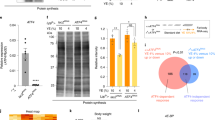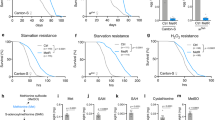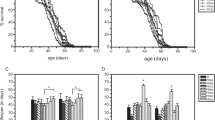Abstract
Dietary restriction extends healthy lifespan in diverse organisms and reduces fecundity1,2. It is widely assumed to induce adaptive reallocation of nutrients from reproduction to somatic maintenance, aiding survival of food shortages in nature3,4,5,6. If this were the case, long life under dietary restriction and high fecundity under full feeding would be mutually exclusive, through competition for the same limiting nutrients. Here we report a test of this idea in which we identified the nutrients producing the responses of lifespan and fecundity to dietary restriction in Drosophila. Adding essential amino acids to the dietary restriction condition increased fecundity and decreased lifespan, similar to the effects of full feeding, with other nutrients having little or no effect. However, methionine alone was necessary and sufficient to increase fecundity as much as did full feeding, but without reducing lifespan. Reallocation of nutrients therefore does not explain the responses to dietary restriction. Lifespan was decreased by the addition of amino acids, with an interaction between methionine and other essential amino acids having a key role. Hence, an imbalance in dietary amino acids away from the ratio optimal for reproduction shortens lifespan during full feeding and limits fecundity during dietary restriction. Reduced activity of the insulin/insulin-like growth factor signalling pathway extends lifespan in diverse organisms7, and we find that it also protects against the shortening of lifespan with full feeding. In other organisms, including mammals, it may be possible to obtain the benefits to lifespan of dietary restriction without incurring a reduction in fecundity, through a suitable balance of nutrients in the diet.
This is a preview of subscription content, access via your institution
Access options
Subscribe to this journal
Receive 51 print issues and online access
$199.00 per year
only $3.90 per issue
Buy this article
- Purchase on Springer Link
- Instant access to full article PDF
Prices may be subject to local taxes which are calculated during checkout




Similar content being viewed by others
References
Weindruch, R. & Walford, R. L. The Retardation of Aging and Disease by Dietary Restriction (Thomas, 1988)
Partridge, L., Gems, D. & Withers, D. J. Sex and death: what is the connection? Cell 120, 461–472 (2005)
Holliday, R. Food, reproduction and longevity: is the extended lifespan of calorie-restricted animals an evolutionary adaptation? Bioessays 10, 125–127 (1989)
Williams, G. C. Natural selection, the costs of reproduction, and a refinement of Lack’s principle. Am. Nat. 100, 687–690 (1966)
Kirkwood, T. B. Evolution of ageing. Nature 270, 301–304 (1977)
Mair, W. & Dillin, A. Aging and survival: the genetics of life span extension by dietary restriction. Annu. Rev. Biochem. 77, 727–754 (2008)
Russell, S. J. & Kahn, C. R. Endocrine regulation of ageing. Nature Rev. Mol. Cell Biol. 8, 681–691 (2007)
Kaeberlein, M., Burtner, C. R. & Kennedy, B. K. Recent developments in yeast aging. PLoS Genet. 3, e84 (2007)
Piper, M. D. & Bartke, A. Diet and aging. Cell Metab. 8, 99–104 (2008)
Colman, R. J. et al. Caloric restriction delays disease onset and mortality in rhesus monkeys. Science 325, 201–204 (2009)
De Marte, M. L. & Enesco, H. E. Influence of low tryptophan diet on survival and organ growth in mice. Mech. Ageing Dev. 36, 161–171 (1986)
Zimmerman, J. A. et al. Nutritional control of aging. Exp. Gerontol. 38, 47–52 (2003)
Miller, R. A. et al. Methionine-deficient diet extends mouse lifespan, slows immune and lens aging, alters glucose, T4, IGF-I and insulin levels, and increases hepatocyte MIF levels and stress resistance. Aging Cell 4, 119–125 (2005)
Klass, M. R. Aging in the nematode Caenorhabditis elegans: major biological and environmental factors influencing life span. Mech. Ageing Dev. 6, 413–429 (1977)
Chapman, T. & Partridge, L. Female fitness in Drosophila melanogaster: an interaction between the effect of nutrition and of encounter rate with males. Proc. R. Soc. Lond. B 263, 755–759 (1996)
Selesniemi, K., Lee, H. J. & Tilly, J. L. Moderate caloric restriction initiated in rodents during adulthood sustains function of the female reproductive axis into advanced chronological age. Aging Cell 7, 622–629 (2008)
Harrison, D. E. & Archer, J. R. Natural selection for extended longevity from food restriction. Growth Dev. Aging 53, 3–6 (1989)
Mair, W., Piper, M. D. & Partridge, L. Calories do not explain extension of lifespan by dietary restriction in Drosophila . PLoS Biol. 7, e223 (2005)
Wong, R. et al. Quantification of food intake in Drosophila . PLoS ONE 4, e6063 (2009)
Piper, M. D. & Partridge, L. Dietary restriction in Drosophila: Delayed aging or experimental artefact? PLoS Genet. 3, e57 (2007)
Spieth, H. T. Courtship behaviour in Drosophila . Annu. Rev. Entomol. 19, 385–405 (1974)
Skorupa, D. A. et al. Dietary composition specifies consumption, obesity, and lifespan in Drosophila melanogaster . Aging Cell 7, 478–490 (2008)
Lee, K. P. et al. Ageing and reproduction in Drosophila: new insights from nutritional geometry. Proc. Natl Acad. Sci. USA 105, 2498–2503 (2008)
Bass, T. M. et al. Optimization of dietary restriction protocols in Drosophila . J. Gerontol. A 62, 1071–1081 (2007)
Sang, J. H. & King, R. C. Nutritional requirements of axenically cultured Drosophila melanogaster adults. J. Exp. Biol. 38, 793–809 (1961)
O’Brien, D. M. et al. Use of stable isotopes to examine how dietary restriction extends Drosophila lifespan. Curr. Biol. 18, R155–R156 (2008)
Fernandez, R. et al. The Drosophila insulin receptor homolog: a gene essential for embryonic development encodes two receptor isoforms with different signaling potential. EMBO J. 14, 3373–3384 (1995)
Ikeya, T. et al. The endosymbiont Wolbachia increases insulin/IGF-like signalling in Drosophila. Proc. R. Soc. B 276, 3799–3807 (2009)
Millward, D. J. et al. Protein quality assessment: impact of expanding understanding of protein and amino acid needs for optimal health. Am. J. Clin. Nutr. 87, 1576S–1081S (2008)
Ikeya, T. et al. Nutrient-dependent expression of insulin-like peptides from neuroendocrine cells in the CNS contributes to growth regulation in Drosophila . Curr. Biol. 12, 1293–1300 (2002)
Lange, H. C. & Heijnen, J. J. Statistical reconciliation of the elemental and molecular biomass composition of Saccharomyces cerevisiae . Biotechnol. Bioeng. 75, 334–344 (2001)
Sang, J. H. in The Genetics and Biology of Drosophila (eds Ashburner, M. & Wright, T. R. F.) 159–192 (Academic, 1978)
Grandison, R. C. et al. Effect of a standardised dietary restriction protocol on multiple laboratory strains of Drosophila melanogaster . PLoS ONE 4, e4067 (2009)
Clancy, D. J. & Kennington, W. J. A simple method to achieve consistent larval density in bottle cultures. Drosoph. Inf. Serv. 84, 168–169 (2001)
R Development Core Team. R: A Language and Environment for Statistical Computing. The R Project for Statistical Computing 〈http://www.R-project.org〉 (2005)
Crawley, M. J. Statistics: An Introduction Using R 103–124 (Wiley, 2005)
Acknowledgements
We acknowledge funding from a Wellcome Trust Strategic Award to L.P. (M.D.W.P. and L.P.) and Research into Ageing (R.C.G. and L.P.). We would also like to thank M. Hoddinott for technical support as well as S. Pletcher and E. Blanc for assistance with statistical analyses.
Author Contributions The project was conceived by M.D.W.P. and L.P., and the experiments were designed by R.C.G., M.D.W.P. and L.P. The experiments were performed and analysed by R.C.G. and M.D.W.P. The manuscript was written by R.C.G., M.D.W.P. and L.P.
Author information
Authors and Affiliations
Corresponding author
Supplementary information
Supplementary Information
This file contains Supplementary Table S1, Supplementary Figures S1-S10 with Legends and Supplementary References. (PDF 613 kb)
Rights and permissions
About this article
Cite this article
Grandison, R., Piper, M. & Partridge, L. Amino-acid imbalance explains extension of lifespan by dietary restriction in Drosophila. Nature 462, 1061–1064 (2009). https://doi.org/10.1038/nature08619
Received:
Accepted:
Published:
Issue Date:
DOI: https://doi.org/10.1038/nature08619
This article is cited by
-
Dietary cysteine and methionine promote peroxisome elevation and fat loss by induction of CG33474 expression in Drosophila adipose tissue
Cellular and Molecular Life Sciences (2024)
-
Pregnane X receptor agonist nomilin extends lifespan and healthspan in preclinical models through detoxification functions
Nature Communications (2023)
-
A new AMPK isoform mediates glucose-restriction induced longevity non-cell autonomously by promoting membrane fluidity
Nature Communications (2023)
-
Eating in a losing cause: limited benefit of modified macronutrient consumption following infection in the oriental cockroach Blatta orientalis
BMC Ecology and Evolution (2022)
-
Fitness of the fall armyworm Spodoptera frugiperda to a new host plant, banana (Musa nana Lour.)
Chemical and Biological Technologies in Agriculture (2022)
Comments
By submitting a comment you agree to abide by our Terms and Community Guidelines. If you find something abusive or that does not comply with our terms or guidelines please flag it as inappropriate.



